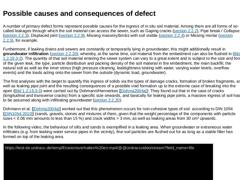
|
A number of primary defect forms represent possible causes for the ingress of in situ soil material. Among them are all forms of so-called leakages through which the soil material can access the sewer, such as Gaping cracks ( (Fissure / Crack (BAB))), Pipe break / Collapse ( (Break / Collapse (BAC))), Displaced joint ( (Displaced joint (BAJ))), Missing masonry/bricks with soil visible ( (Defective brickwork or masonry (BAD))) or Missing mortar ( (… |
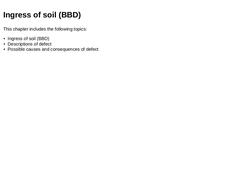
|
|
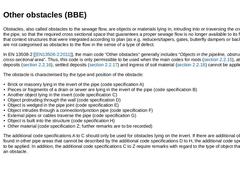
|
Obstacles, also called obstacles to the sewage flow, are objects or materials lying in, intruding into or traversing the cross section of the pipe, so that the required cross sectional space that guarantees a proper sewage flow is no longer available to its full extent. In that context structures that were integrated according to plan (as e.g. reducers/tapers, gates, butterfly dampers or backflow traps) are not categorised as obstacles to the flow … |
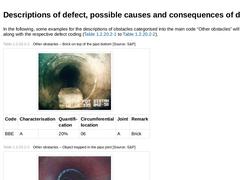
|
In the following, some examples for the descriptions of obstacles categorised into the main code “Other obstacles” will be illustrated along with the respective defect coding (Image 2‑132 to Image 2‑138). (Table: Other obstacles – Brick on top of the pipe bottom) (Table: Other obstacles – Object trapped in the pipe joint) (Table: Other obstacles – Third party pipe traversing the piping) (Table: Other obstacles – Anchor rod drilled through a sewer) (Table: … |
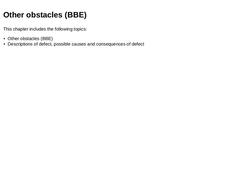
|
|
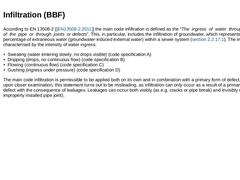
|
According to EN 13508-2 [ [EN13508-2:2011]] the main code infiltration is defined as the “The ingress of water through the wall of the pipe or through joints or defects”. This, in particular, includes the infiltration of groundwater, which represents the decisive percentage of extraneous water (groundwater-induced external water) within a sewer system ( (Origin and composition of solids in sewer systems)). The infiltration is characterised by the … |
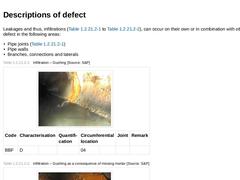
|
Leakages and thus, infiltrations (Image 2‑140 to Image 2‑142), can occur on their own or in combination with other types of defect in the following areas: -
Pipe joints (Image 2‑140)
-
Pipe walls
-
Branches, connections and laterals
(Table: Infiltration – Gushing) (Table: Infiltration – Gushing as a consequence of missing mortar) (Table: Infiltration – Gushing) |
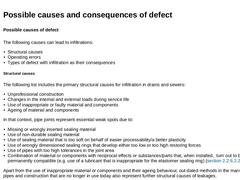
|
Possible causes of defect The following causes can lead to infiltrations: -
Structural causes
-
Operating errors
-
Types of defect with infiltration as their consequences
Structural causes The following list includes the primary structural causes for infiltration in drains and sewers: -
Unprofessional construction
-
Changes in the internal and external loads during service life
-
Use of inappropriate or faulty material and components
-
Ageing of material and …
|
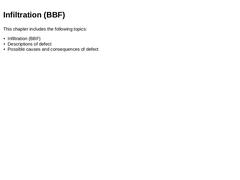
|
|
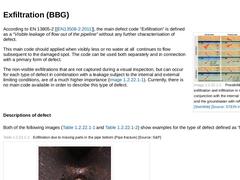
|
(Image: Possibilities of the exfiltration and infiltration in sewer systems in conjunction with the internal water pressure and the groundwater with reference to [Stein90e] [Image: S&P GmbH]) According to EN 13805-2 [ [EN13508-2:2011]], the main defect code “Exfiltration” is defined as a “Visible leakage of flow out of the pipeline” without any further characterisation of defect. This main code should applied when visibly less or no water at all continues … |
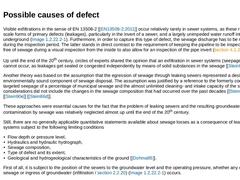
|
Visible exfiltrations in the sense of EN 13508-2 [ [EN13508-2:2011]] occur relatively rarely in sewer systems, as these require large-scale forms of primary defects (leakages), particularly in the invert of a sewer, and a largely unimpeded water runoff into the underground (Image 2‑148). Furthermore, in order to capture this type of defect, the sewage discharge has to be maintained during the inspection period. The latter stands in direct contrast … |
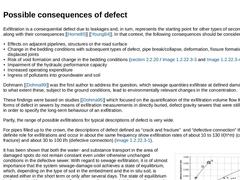
|
Exfiltration is a consequential defect due to leakages and, in turn, represents the starting point for other types of secondary defect along with their consequences [ [Horne85]] [ [Young84]]. In that context, the following consequences should be considerd: -
Effects on adjacent pipelines, structures or the road surface
-
Change in the bedding conditions with subsequent types of defect, pipe break/collapse, deformation, fissure formation or displaced …
|
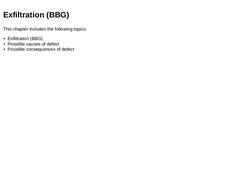
|
|

|
In addition to the main codes that are used to describe the structure and operation of drains and sewers, EN 13508-2 [ [EN13508-2:2011]] also includes “survey codes” and so-called “additional codes”. Both code groups do not serve the purpose to describe a type of defect, but are used to further specify an inspected pipeline and are not explained in detail. Further information in that context can be found in EN 13508-2 [ [EN13508-2:2011]] and DWA-M … |
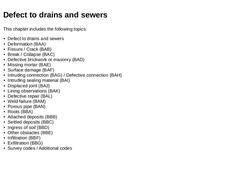
|
|
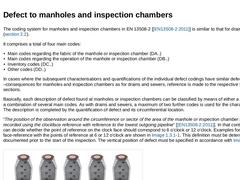
|
The coding system for manholes and inspection chambers in EN 13508-2 [ [EN13508-2:2011]] is similar to that for drains and sewers ( (Defect to drains and sewers)). It comprises a total of four main codes: -
Main codes regarding the fabric of the manhole or inspection chamber (DA..)
-
Main codes regarding the operation of the manhole or inspection chamber (DB..)
-
Inventory codes (DC..)
-
Other codes (DD..)
In cases where the subsequent characterisations … |
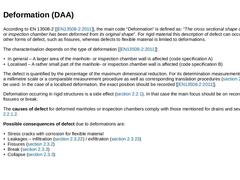
|
According to EN 13508-2 [ [EN13508-2:2011]], the main code “Deformation” is defined as: “The cross sectional shape of the manhole or inspection chamber has been deformed from its original shape”. For rigid material this description of defect can occur along with other forms of defect, such as fissures, whereas defects to flexible material is limited to deformations. The characterisation depends on the type of deformation [ [EN13508-2:2011]]: |
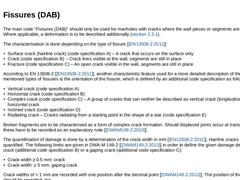
|
The main code “Fissures (DAB)” should only be used for manholes with cracks where the wall pieces or segments are still in place. Where applicable, a deformation is to be described additionally ( (Deformation (DAA))). The characterisation is done depending on the type of fissure [ [EN13508-2:2011]]: -
Surface crack (hairline crack) (code specification A) – A crack that occurs on the surface only
-
Crack (code specification B) – Crack lines visible at …
|
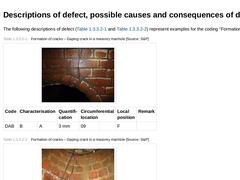
|
The following descriptions of defect (Image 2‑155 and Image 2‑156) represent examples for the coding “Formation of cracks”. (Table: Formation of cracks – Gaping crack in a masonry manhole) (Table: Formation of cracks – Gaping crack in a masonry manhole) Possible causes of defect The following possible causes for the formation of cracks at manholes and inspection chambers are worth considering [ [ATVM143-1:2004]]: -
Defect to structural components during …
|
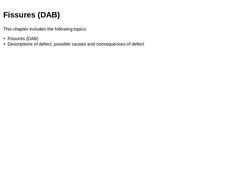
|
|
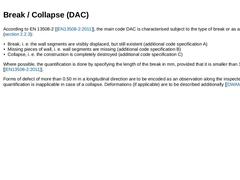
|
According to EN 13508-2 [ [EN13508-2:2011]], the main code DAC is characterised subject to the type of break or as a collapse ( (Break / Collapse (BAC))): -
Break, i. e. the wall segments are visibly displaced, but still existent (additional code specification A)
-
Missing pieces of wall, i. e. wall segments are missing (additional code specification B)
-
Collapse, i. e. the construction is completely destroyed (additional code specification C)
Where … |
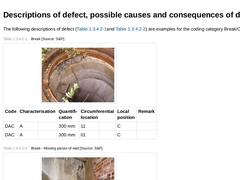
|
The following descriptions of defect (Image 2‑157 and Image 2‑158) are examples for the coding category Break/Collapse. (Table: Break) (Table: Break - Missing pieces of wall) Possible causes of defect Possible causes of a break or collapse of a manhole or inspection chamber are always other forms of defect (primary defect), such as e.g. cracks, leakages, corrosion etc. combined with an additional dysfunction or changed load ( (Break / Collapse (BAC))). … |
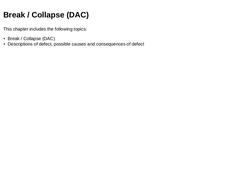
|
|
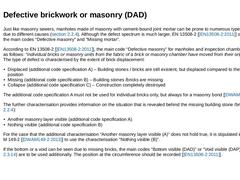
|
Just like masonry sewers, manholes made of masonry with cement-bound joint mortar can be prone to numerous types of defect due to different causes ( (Defective brickwork or masonry (BAD))). Although the defect spectrum is much larger, EN 13508-2 [ [EN13508-2:2011]] only captures the main codes “Defective masonry” and “Missing mortar”. According to EN 13508-2 [ [EN13508-2:2011]], the main code “Defective masonry” for manholes and inspection chambers … |
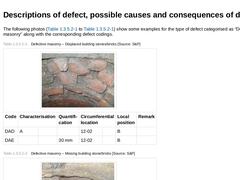
|
The following photos (Image 2‑159 to Image 2‑162) show some examples for the type of defect categorised as “Defective masonry” along with the corresponding defect codings. (Table: Defective masonry – Displaced building stones/bricks) (Table: Defective masonry – Missing building stone/brick) (Table: Defective masonry – Displaced and missing building stones/bricks) (Table: Defective masonry – Missing building stones/bricks) Possible causes and consequences … |